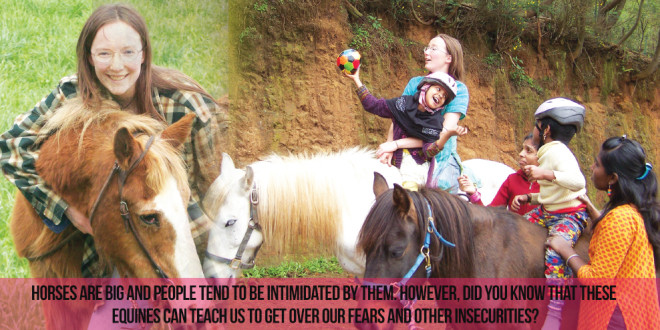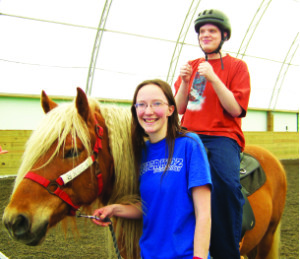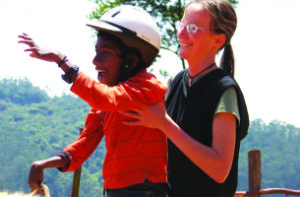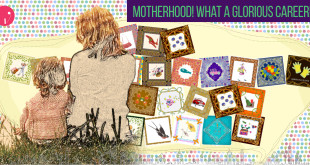Horses are big and people tend to be intimidated by them. However, did you know that these equines can teach us to get over our fears and other insecurities?
Tell us a bit about yourself, Laura, your background, family.
Laura: I was raised in a Christian family. We lived in the country, on a small farm, and was home- schooled with my brother and sister.
How did you develop your passion for India?
Laura: I’ve been interested in India since I read a book for school about Amy Carmichael. I reread it several times, and always hoped I’d be able to come to India. My first time here, I stayed in a guesthouse where she used to stay, so that was pretty exciting. I’m not quite sure whatit is exactly that makes me need to return here, but I just seem to keep coming back. It’s like a boomerang
What do you do here and what compels you to live and work here.
Laura: In 2009, I read about an organization called Freedom Firm in India that does Horse Therapy. I decided I wanted to work with, contacted them, and within 6 months was stepping off the plane in Coimbatore.
What is the History of Horse Therapy?
Laura: The concept of horse therapy was known as early as 460 B.C., when the Romans used it for injured soldiers. The movement of a walking horse mimics the movement of a walking human, so a rider who is unable to walk can still exercise their legs as though walking, thereby teaching their legs to walk. The warmth and movement of the horse’s muscles also heats and stretches the rider’s muscles, working them with less of a chance of injury.
Subscribe our Magazines
Indian Subscribers Click here
Overseas Subscribers Click here
In modern times, horse therapy began to gain popularity in the 1940s. A Danish equestrian athlete named Liz Hartel was paralyzed by polio. She was eventually able to use most of her muscles, though she was still paralyzed from the knees down and could not use her arms and hands properly. In spite of the fact that she had to be helped on and off of her horse, and her Doctor told her not to ride, she continued to ride. She went on to be the first woman to ever be allowed in the equestrian events in the Olympics.
Liz Hartel won the silver medal in 1952.
Following her success, the eyes of the western world opened to horse therapy, and it began to grow in popularity across Europe and North America. Now it is spreading throughout the rest of the world.
How did you get into Horse Therapy?
Laura: My Aunt Neita has helped people with horse therapy. I heard her talking about it frequently. In the beginning, as a child, I just used it as a way to spend more time with horses. I soon realized that just because someone has a disability doesn’t mean that they are so different.
A couple of years engaging with the idea, Aunty Neita became an expert with horse therapy. Our classes started to get too large for her to focus on each rider. I was frequently her co-instructor. In this way, I was able to learn how to teach therapy, rather than simply leading the horses.
What you need to have with a horse is a partnership. Dominating a horse may get the horse to go through the motions of what you ask him to do, but it will be lacking spirit
Elaborate on the connections horses can have with people. Does this work with other animals?
Laura: Horses are huge, strong animals, but they are herd animals. They want to be accepted by the group they are in – be it their herd or the people they are with. In fact, a horse will consider the humans that work with it to be part of its herd. It wants someone who will lead it, someone it can trust. The average horse prefers to have someone guide it, even if it is a human, and someone smaller than the horse.
If the horse thinks that it can trust the person, it will do what is asked of it. Horses are more willing to be partners with a human than most animals are. What you need to have with a horse is a partnership. Dominating a horse may get the horse to go through the motions of what you ask him to do, but it will be lacking spirit.
To get an animal that size, and with such a flight instinct to listen to you, and walk into scary situations, or let you do scary things on its back, you have to build trust, and prove over and over again that you will not let them down. It’s very much like working with the at-risk kids. They are used to people not being trustworthy, and to get their trust, you have to continually prove your trustworthiness. When these kids are working with horses, and proving that they can be trusted, and learning to trust the horse, they begin to realize that trust is a real possibility.
Horses are big; people tend to be intimidated by them. That is often one of the biggest barriers to therapy. However, horses teach people to get over their fears, especially when they realize that horses are often more timid than humans. Horses look to the people in charge of them for direction on whether they should be afraid or not.
I was working with Skye, a therapy horse who had been determined unusable. He would spin and try to run out of the arena, back to the stalls in the barn. No one knew what was wrong with him. I realized that he was scared of the mirrors we had hung on the walls for riders to see their form. He didn’t know how to react when he saw the “other horse” appear in the mirror next to him.
I spent quite a while before the lesson, walking up to the mirror with him, each time getting a little closer to it. He was still nervous, but took his cues from me. Each time we walked toward the mirror, Skye showed less concern. Finally, he was able to walk right up to the mirror and look at himself without fear. We used him later for a lesson, and he did not even hesitate as he walked into the arena.
A lot of people can be skeptical of horse therapy. How would you convince them on its benefits?
The best way to convince them usually is to give them stories where horse therapy has been effective
Laura: Most people have never had experiences with horses; have never found out for themselves the physical and psychological benefits of being with horses. The best way to convince them usually to give them stories where horse therapy has been effective. The best way to convince them is to invite them to see horse therapy.
I worked with a group of students last year who were doing horse therapy only to fulfill community service obligations. They had no idea what the benefits were of horse therapy, and thought it was just a chance for kids to have fun riding. In three months, the students involved were surprised by how much they learned, and the change they were able to see in the kids who rode.
Narrate some of your experiences from working with children\riders and horses.
Laura: When working in the United States, there was one young boy named Ryan. He was around my age. Ryan did not speak and didn’t seem to like riding. He didn’t respond to the things we asked him to do. We tried different horses with him, and just didn’t find one that clicked. Until one day, I brought out Brock, this goofy young horse that most people found to be too pushy for their liking.
Brock and I had a certain understanding. I put up with his silliness as long as he respected me and did as I asked. When the three of us, Brock, Ryan, and I, were together as a team, we saw improvements in Ryan. He still pretended to ignore what I asked him to do, but he couldn’t keep a smile off of his face. He would look the other way, but do as I asked. Any time Brock was stubborn and pushed me around, Ryan got the biggest smile on his face, and at times even laughed. We were all startled the first time we heard Ryan laugh. He became engaged and responsive. Even when he “ignored” us, it was a game he was playing with us.
He figured out how to communicate even though he couldn’t speak, and had reason to be involved with the lesson. The workers who came with Ryan said that every week when they arrived, Ryan looked for Brock and me.
There was a boy named Rahul in Ooty who could not walk on his own. In order to stay on horseback someone had to sit behind and hold him. The first few times he rode, his legs were so stiff that he could barely straddle the horse. The more often he rode, the more his legs relaxed, and they were not so stiff and straight. He was able to ride with less and less support.
His favorite thing to do while riding was to go fast. Any time we let his horse jog, Rahul laughed so hard that he doubled up. He completely ignored the fact that he was on horseback and could fall off. Even as his riding improved, and he could sit on the horse with very little help, his back rider had to hold him tightly because he never did lose that uninhibited joy at going fast.
What are the organizations working with people and horses in the States and in India?
Laura: PATH International is one of the biggest organizations, both in the U.S., and in many other countries. In India it is mostly individuals who are starting up therapy centers.
What are some of the signs of a horse’s mood, also in your experience – how have you seen horses take up the good\bad moods of people who are around them?
Laura: Body language is a big indicator of a horse’s moods. Horses are typically quiet animals, and you have to observe them to know their mood. A relaxed tail, a cocked foot, ears swishing lazily back and forth indicate a relaxed horse. Ears pointed straight-forward, front legs stiff, eyes and nostrils wide indicate a nervous horse. Sometimes a horse will have his ears back just because he is listening to something behind him.
My pony, Gram, was usually the one I went to when there was something wrong when I was younger. She has always been very sensitive to my emotions. One day, I was very upset, and I went out to the pasture to spend time with Gram. I had my arms around her neck, and was crying, and she put her neck around me, squeezing me tight in a horse hug, then reached down and licked my knee like a dog would. This isn’t something a typical horse does, and Gram especially doesn’t do it in normal life. But she knew I was upset, and was comforting me in the best way she knew.
What is your vision with regards to horse therapy in India? Is it one of those initiatives earlier than its time here in India? Will it catch on?
Laura: I would love to see horse therapy growing more all over India. It has been in use for so long in different parts of the world, and is such an effective method of therapy. I am going to be starting my second program in India in October, It seems like such a small thing, only starting two such programs in all of India over a period of five years, but any little bit makes a change.
Not only does horse therapy benefit the riders, it also brings attention to the fact that horses can be companion animals, and have value beyond simply being tools. This seems to be a totally foreign concept in much of India, where people prize their horses, but don’t really know how to communicate with them.
I love doing therapy in India, but it isn’t something a westerner needs to come and teach. It would be brilliant if some of the people who are doing therapy would train staff to go out and start therapy centers. I’ve had people in India tell me that they have heard of horse therapy, and would love to do it, but don’t know of anyone in their country who can teach them. If it is taught by Indians, I feel like it will be much more effective.
I love doing therapy in India, but it isn’t something a westerner needs to come and teach
How much of your life would you say is built around horses and other animals?
Laura: A lot of my life is built around animals. When I was little, I would sneak out of the house at two or three in the morning, especially when the moon was full, to spend time with my pony. It just seemed like a normal thing to do. Why lay in bed trying to fall asleep when you have your own horse right outside?
 Juliet Thomas Christian Articles for Young Women
Juliet Thomas Christian Articles for Young Women




